When it comes to the slope of your roof, there’s not a single standard roof pitch that you can follow. Rather you need to consider factors like climate, location, material of roof etc., before finalizing. Anyhow, it’s still a good idea to know some standard roof pitch range so you can get a guide.
So, if you’re new for roof pitch or don’t know how to choose one for your roof, here’s a lead:
What is roof pitch?
The roof pitch is the angle at which the roof rises, and it is measured as the ratio of the rise to the span of the roof. A roof pitch is basically the slope of a roof which can range from very low to steep. It is generally measured as vertical rise divided by horizontal run.

Factors effecting the roof pitch
There are numbers of factors that influence the pitch which include
- Climate
- Building location
- Architectural style
- Material used
- Availability of material for the construction
Benefits of sloping roof
There are number of benefits one can get having a sloped roof including;
- Water drainage
- Snow shedding
- Enhances weight bearing capability
- Provides wind resistance
- Decreased heat loss in cold climate due to thermal insulation provided by the eaves
Also Read: 6 Types of Hip Roof – Cost – Lifespan – Advantages – Disadvantages
Standard roof pitch vs snow shed or rain drainage
Any house with steep pitch will drain faster after heavy rainstorm because there is less surface area in contact with the ground preventing water from seeping into the crack that might have developed in the wood structure over the time or more intense damage in metal frame structures.
Also Read: What is a 8 on 12 roof pitch – 8/12 roof pitch (with Calculator)
The roof pitch has a significant impact on how much snow is able to accumulate and the stability of the house in winter season.
A steep slope will shed snow effortlessly; however, it can be more difficult to walk up during a storm. Whereas a shallow slope may collect too much snow and one can have difficulty shedding water away from the structure when it rains.
Similarly, the flatter the pitch, the greater the thermal insulation for cold climate.
Also Read: How many bundles of shingle do I need for 1000 – 1200 – 1500 – 2000 – 3000 sq. ft. Roof?
Types of Roof Pitches
The roof pitches are the incline of the roof. A pitch of zero degree means that the angle between the roof and the ground is always on unit. There are three types of roof pitches that includes flat roof pitches, low slope pitches, and steep slopes pitches.
Flat Roof Pitches
These kind of roof pitches are most suited for sheds, garages, and warehouses. The pitch of a flat roof is equals to zero and may fall under 2/12 pitch category. Which means they are below 9.76o roof pitches. They rise 2 inches for every 12 inches of run represents 9.46o roof pitch. Flat pitches need to be maintained and waterproofed so that the water does not penetrate through the roof and harm the house.
Also Read: Rough opening for a garage door of sizes 16′, 18′, 8′, 9′, 10′, 12′
Low Slope Pitches
The Low slope pitches also ranges from 9.5o to 18.43o but only with some exceptions when there are overhang or other architectural design on the house that increases the pitch. These types of pitches fall under 2/12 to 4/12 pitch. They are easier than flat roof pitches to maintain, however, they will need more maintenance work than a steep roof pitch.
Also read: Hip and Valley Roof – The Pros and Cons
Steep Slope Pitches
These pitches are the toughest and most expensive types of roof pitches to construct as stairs must be installed on the roof itself making it more hectic and costly. The steep slope pitch ranges from 4/12 and 12/12 pitch which means 18.43o to 45o.
Difference between Slope and Pitch of the Roof
The Slope of a roof is the inclined in the shape of a roof and it is expressed as a ratio of the vertical rise to the horizontal run, also the ratio is always given as inches per foot. A 4/12 slope refers to a roof that rises 4 inches after every 12 inches of run. Similarly, if the rise is 6 inches for every 12 inches of run then the roof slope is 6/12. Normally, slope is measured as a ratio and in inches per foot.
Whereas a pitch of a roof is the inclined of a roof represented as a fraction calculated by dividing the rise by the span. The roof span is the distance between the outside of wall’s top plate and the outside of another wall’s top plate. In old times, pitch referred to a ratio of the ridge height to the total width of the building and ridge was normally in the middle of the span back then, but now in modern construction procedures the ridge can be positioned anywhere throughout the span weather its from the center or from the endpoint.
What is the Standard Roof Slope?
A standard roof slope that are often used range from 4/12 to 9/12 however, pitches less than 4/12 have a tiny incline and are tagged as low-slope roof. So, if the pitch is only slightly inclined, pitches less than 2/12 are considered flat roofs.
What is the Minimum Roof Pitch?
As discussed earlier, the roof pitch is the amount of slope from one level to another and it varies by design requirement. Whereas the minimum roof pitch is usually 3 inches per foot which means 3 inches for every 12 inches of run means 14.04o roof pitch. So, in order to make sure your roof is structurally sound, the pitch of the roof needs to be at least 14o. However, if the home is located in a region that gets heavy rain and high amounts of snow accumulation during winter season then this requirement does apply. Therefore, 3/12 slope is suggested as minimum slope required for water drainage purposes.
What is the perfect Roof Pitch?
The pitch of a roof affects many aspects of a building, which includes its structural design integrity, energy efficiency, and aesthetic appearance. There is no hard and fast rule when it comes to perfect roof pitch. There are numbers of factors that affect it’s slope like where you are living and what kind of climate you are dealing with. That being said, most expert suggest that roofs should have a 12 to 37-degree incline for optimal performance and safety in snowy regions. So whichever slope works best for you, is the perfect roof pitch if it is not violating any air rights.

















